
Blue whale underwater closeup photo. This picture of a blue whale, the largest animal ever to inhabit earth, shows it swimming through the open ocean, a rare underwater view. Since this blue whale was approximately 80-90' long and just a few feet from the camera, an extremely wide lens was used to photograph the entire enormous whale.
Species: Blue whale, Balaenoptera musculus
Location: California
Image ID: 27299
Species: Blue whale, Balaenoptera musculus
Location: California
Image ID: 27299
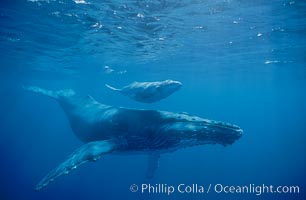
North Pacific humpback whales, a mother and calf pair swim closely together just under the surface of the ocean. The calf will remain with its mother for about a year, migrating from Hawaii to Alaska to feed on herring.
Species: Humpback whale, Megaptera novaeangliae
Location: Maui, Hawaii
Image ID: 00140
Species: Humpback whale, Megaptera novaeangliae
Location: Maui, Hawaii
Image ID: 00140
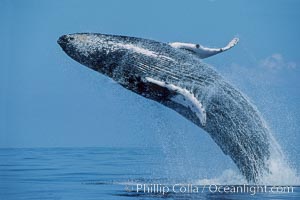
Humpback whale breaching, near Molokai, Hawaii. Megaptera novaeangliae. It is suspected the breaching often has a communicative purpose which depends on the behavioral context of the moment.
Species: Humpback whale, Megaptera novaeangliae
Location: Maui, Hawaii
Image ID: 00205
Species: Humpback whale, Megaptera novaeangliae
Location: Maui, Hawaii
Image ID: 00205
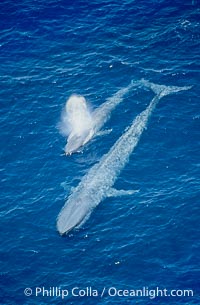
Two blue whales, a mother and her calf, swim through the open ocean in this aerial photograph. The calf is blowing (spouting, exhaling) with a powerful column of spray. The blue whale is the largest animal ever to live on Earth.
Species: Blue whale, Balaenoptera musculus
Location: San Diego, California
Image ID: 02304
Species: Blue whale, Balaenoptera musculus
Location: San Diego, California
Image ID: 02304
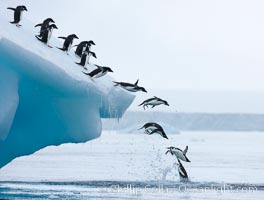
Adelie penguins leaping into the ocean from an iceberg.
Species: Adelie penguin, Pygoscelis adeliae
Location: Brown Bluff, Antarctic Peninsula, Antarctica
Image ID: 25005
Species: Adelie penguin, Pygoscelis adeliae
Location: Brown Bluff, Antarctic Peninsula, Antarctica
Image ID: 25005
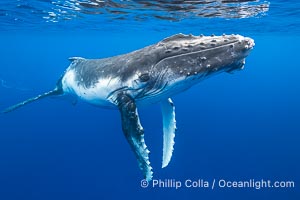
Inquisitive Calf South Pacific Humpback Whale Underwater, Moorea, French Polynesia.
Species: Humpback whale, Megaptera novaeangliae
Location: Moorea, French Polynesia, France
Image ID: 40638
Species: Humpback whale, Megaptera novaeangliae
Location: Moorea, French Polynesia, France
Image ID: 40638

Two Adelie penguins, holding their wings out, standing on an iceberg.
Species: Adelie penguin, Pygoscelis adeliae
Location: Paulet Island, Antarctic Peninsula, Antarctica
Image ID: 25007
Species: Adelie penguin, Pygoscelis adeliae
Location: Paulet Island, Antarctic Peninsula, Antarctica
Image ID: 25007
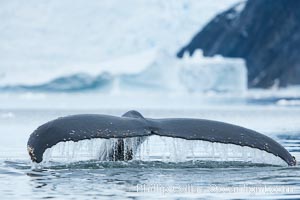
Humpback whale in Antarctica. A humpback whale swims through the beautiful ice-filled waters of Neko Harbor, Antarctic Peninsula, Antarctica.
Species: Humpback whale, Megaptera novaeangliae
Location: Neko Harbor, Antarctic Peninsula, Antarctica
Image ID: 25646
Species: Humpback whale, Megaptera novaeangliae
Location: Neko Harbor, Antarctic Peninsula, Antarctica
Image ID: 25646
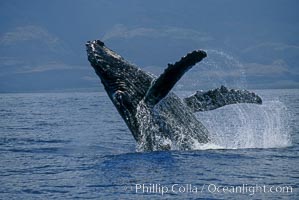
Humpback whale breaching with pectoral fins lifting spray from the ocean surface.
Species: Humpback whale, Megaptera novaeangliae
Location: Maui, Hawaii
Image ID: 03854
Species: Humpback whale, Megaptera novaeangliae
Location: Maui, Hawaii
Image ID: 03854
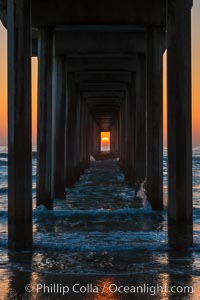
Scripps Pier solstice, sunset aligned perfectly with the pier.
Location: Scripps Institution of Oceanography, La Jolla, California
Image ID: 28475
Location: Scripps Institution of Oceanography, La Jolla, California
Image ID: 28475
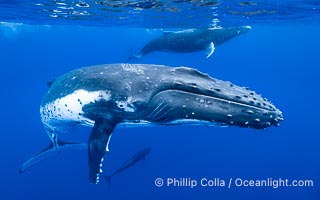
South Pacific Humpback Whales Underwater, Moorea, French Polynesia. A short-finned pilot whale photo-bombs in the background.
Species: Humpback whale, Megaptera novaeangliae
Location: Moorea, French Polynesia, France
Image ID: 40655
Species: Humpback whale, Megaptera novaeangliae
Location: Moorea, French Polynesia, France
Image ID: 40655
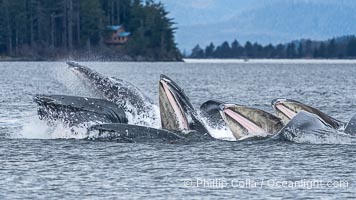
Humpback whales bubblenet feeding in Southeast Alaska. Coordinated bubble-net feeding is a specialized cooperative feeding technique used by humpback whales, where a group of whales works together to trap fish or krill in a net of bubbles then lunge through to feed.
Species: Humpback whale, Megaptera novaeangliae
Location: Sitka Sound, Alaska
Image ID: 40921
Species: Humpback whale, Megaptera novaeangliae
Location: Sitka Sound, Alaska
Image ID: 40921

Blue whale underwater photo showing entire whale head (rostrum) to tail (fluke). This picture of a blue whale shows it swimming through the open ocean, a rare underwater view. Specialized underwater camera gear, including an extremely wide lens, was used to capture the entire enormous whale in a single photograph.
Species: Blue whale, Balaenoptera musculus
Location: California
Image ID: 27300
Species: Blue whale, Balaenoptera musculus
Location: California
Image ID: 27300
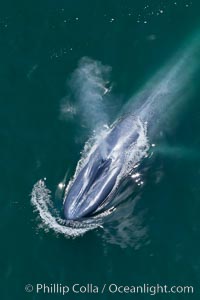
Enormous blue whale, exhaling as it surfaces from a dive, aerial photo. The blue whale is the largest animal ever to have lived on Earth, exceeding 100' in length and 200 tons in weight.
Species: Blue whale, Balaenoptera musculus
Location: Redondo Beach, California
Image ID: 25950
Species: Blue whale, Balaenoptera musculus
Location: Redondo Beach, California
Image ID: 25950
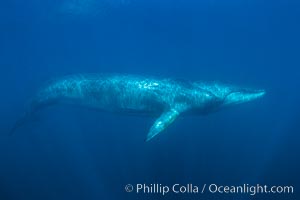
Fin whale underwater. The fin whale is the second longest and sixth most massive animal ever, reaching lengths of 88 feet.
Species: Fin whale, Balaenoptera physalus
Image ID: 27594
Species: Fin whale, Balaenoptera physalus
Image ID: 27594
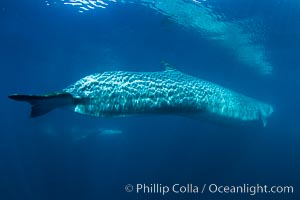
Fin whale underwater. The fin whale is the second longest and sixth most massive animal ever, reaching lengths of 88 feet.
Species: Fin whale, Balaenoptera physalus
Image ID: 27597
Species: Fin whale, Balaenoptera physalus
Image ID: 27597
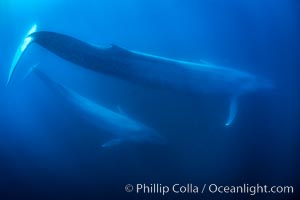
Blue whales, adult and juvenile (likely mother and calf), swimming together side by side underwater in the open ocean.
Species: Blue whale, Balaenoptera musculus
Location: San Diego, California
Image ID: 34568
Species: Blue whale, Balaenoptera musculus
Location: San Diego, California
Image ID: 34568
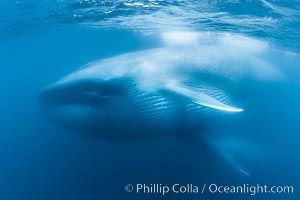
Blue whales feeding on krill underwater closeup photo. A picture of a blue whale with its throat pleats inflated with a mouthful of krill. A calf swims behind and below the adult. Over 80' long and just a few feet from the camera, an extremely wide lens was used to photograph the entire enormous whale.
Species: Blue whale, Balaenoptera musculus
Location: California
Image ID: 27314
Species: Blue whale, Balaenoptera musculus
Location: California
Image ID: 27314
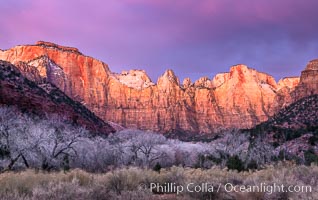
West Temple, The Sundial and the Altar of Sacrifice illuminated by soft alpenglow, about 20 minutes before sunrise.
Location: Zion National Park, Utah
Image ID: 37788
Location: Zion National Park, Utah
Image ID: 37788
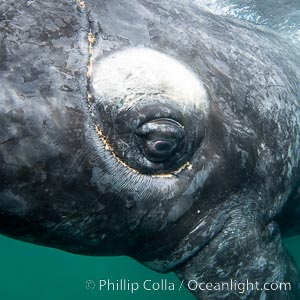
Southern right whale eyeballing the camera up close, Eubalaena australis. Whale lice can be seen clearly in the folds and crevices around the whales eye and lip groove.
Species: Southern Right Whale, Eubalaena australis
Location: Puerto Piramides, Chubut, Argentina
Image ID: 38401
Species: Southern Right Whale, Eubalaena australis
Location: Puerto Piramides, Chubut, Argentina
Image ID: 38401

Parasitic zoanthid anemones cover, encrust and overwhelm a golden gorgonian. The gorgonian on the left has been completely parasitized by zoanthid anemones, while the gorgonian to the right remains free of zoanthids (for now). A garibaldi swims below the two sea fans. The golden gorgonian is a filter-feeding temperate colonial species that lives on the rocky bottom at depths between 50 to 200 feet deep. Each individual polyp is a distinct animal, together they secrete calcium that forms the structure of the colony. Gorgonians are oriented at right angles to prevailing water currents to capture plankton drifting by.
Species: California golden gorgonian, Luminescent parazoanthid, Zoanthid anemone, Giant kelp, Muricea californica, Parazoanthus lucificum, Savalia lucifica, Macrocystis pyrifera
Location: San Clemente Island, California
Image ID: 38493
Species: California golden gorgonian, Luminescent parazoanthid, Zoanthid anemone, Giant kelp, Muricea californica, Parazoanthus lucificum, Savalia lucifica, Macrocystis pyrifera
Location: San Clemente Island, California
Image ID: 38493
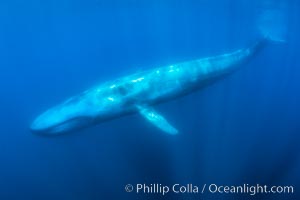
A huge blue whale swims through the open ocean in this underwater photograph. The blue whale is the largest animal ever to live on Earth.
Species: Blue whale, Balaenoptera musculus
Location: San Diego, California
Image ID: 34567
Species: Blue whale, Balaenoptera musculus
Location: San Diego, California
Image ID: 34567
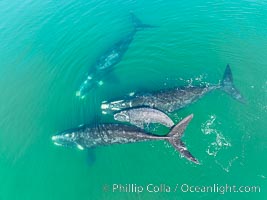
Mother and calf southern right whales are seen here as part of a larger courtship group, with adult males interested in mating with the mother. The calf has no choice but to stay by her mother's side during the courting activities.
Species: Southern Right Whale, Eubalaena australis
Location: Puerto Piramides, Chubut, Argentina
Image ID: 38381
Species: Southern Right Whale, Eubalaena australis
Location: Puerto Piramides, Chubut, Argentina
Image ID: 38381
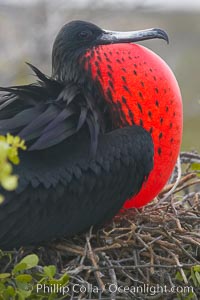
Magnificent frigatebird, adult male on nest, with throat pouch inflated, a courtship display to attract females.
Species: Magnificent frigatebird, Fregata magnificens
Location: North Seymour Island, Galapagos Islands, Ecuador
Image ID: 16725
Species: Magnificent frigatebird, Fregata magnificens
Location: North Seymour Island, Galapagos Islands, Ecuador
Image ID: 16725

Mesa Arch spans 90 feet and stands at the edge of a mesa precipice thousands of feet above the Colorado River gorge. For a few moments at sunrise the underside of the arch glows dramatically red and orange.
Location: Island in the Sky, Canyonlands National Park, Utah
Image ID: 18040
Location: Island in the Sky, Canyonlands National Park, Utah
Image ID: 18040
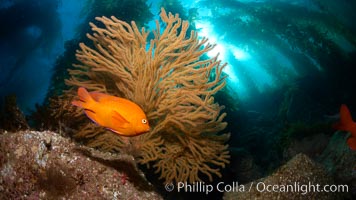
Garibaldi and golden gorgonian, with a underwater forest of giant kelp rising in the background, underwater.
Species: California golden gorgonian, Garibaldi, Hypsypops rubicundus, Muricea californica
Location: Catalina Island, California
Image ID: 23432
Species: California golden gorgonian, Garibaldi, Hypsypops rubicundus, Muricea californica
Location: Catalina Island, California
Image ID: 23432
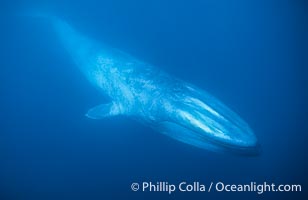
A huge blue whale swims through the open ocean in this underwater photograph. The blue whale is the largest animal ever to live on Earth.
Species: Blue whale, Balaenoptera musculus
Image ID: 03027
Species: Blue whale, Balaenoptera musculus
Image ID: 03027
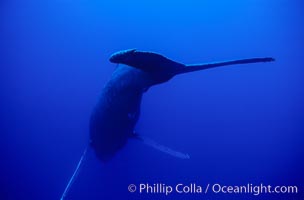
Adult male humpback whale singing, suspended motionless underwater. Only male humpbacks have been observed singing. All humpbacks in the North Pacific sing the same whale song each year, and the song changes slightly from one year to the next.
Species: Humpback whale, Megaptera novaeangliae
Location: Maui, Hawaii
Image ID: 02796
Species: Humpback whale, Megaptera novaeangliae
Location: Maui, Hawaii
Image ID: 02796
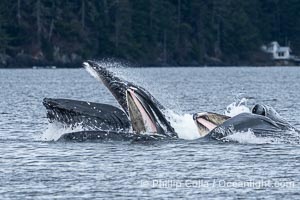
Humpback whales bubblenet feeding in Southeast Alaska. Coordinated bubble-net feeding is a specialized cooperative feeding technique used by humpback whales, where a group of whales works together to trap fish or krill in a net of bubbles then lunge through to feed.
Species: Humpback whale, Megaptera novaeangliae
Location: Sitka Sound, Alaska
Image ID: 40920
Species: Humpback whale, Megaptera novaeangliae
Location: Sitka Sound, Alaska
Image ID: 40920
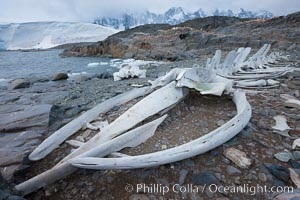
Blue whale skeleton in Antarctica, on the shore at Port Lockroy, Antarctica. This skeleton is composed primarily of blue whale bones, but there are believed to be bones of other baleen whales included in the skeleton as well.
Species: Blue whale, Balaenoptera musculus
Location: Port Lockroy, Antarctic Peninsula, Antarctica
Image ID: 25604
Species: Blue whale, Balaenoptera musculus
Location: Port Lockroy, Antarctic Peninsula, Antarctica
Image ID: 25604